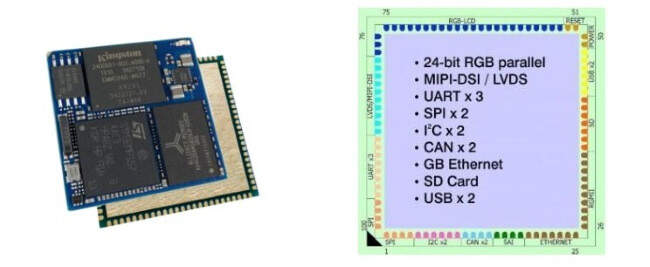Direct Insights Release their Latest SoM
| 17-07-2020 | By Robin Mitchell
Direct Insights released their latest System-on-Module combining an ST32M1, up to 512MB of RAM, and 4GB of FLASH. What are SoM’s, how are they useful in designs, and what does this new SoM provide for engineers?
What are SoCs?
The term SoC, which stands for System-On-Chip, applies to single-chip devices that integrate most, if not all, parts of a complete system. While SoCs power most single board computers, tablets, and smartphones these days, one of the most famous ones is the Broadcom range that power the Raspberry Pi. These devices include the CPU, GPU, memory controller, and I/O in a single device while memory and physical connections are found externally. SoCs allow for complex designs to be made much smaller than if they were made from multiple ICs, which is one of the reasons that smartphones exist as they currently do.
However, SoCs are not the only option available to designers as some designs require the use of additional components that cannot exist inside a chip. For example, a Bluetooth SoC still requires the use of an external antenna which may require capacitors, resistors, and inductors. The use of external components also brings in issues with EMC; radio and high-frequency circuits are notorious for breaching EMC regulations. This is when System-on-modules come in.
System-on-module
A System-On-Module, or SoM, is a board that, just like SoCs, hold a number of components that work together to provide a functional system. However, while SoCs use a single chip, a SoM use either a PCB or substrate to hold multiple ICs and supporting components such as antenna, capacitors, resistors, inductors, and power supplies. While SoMs provide less processing power per unit area, they do have several major advantages over SoCs. The first is that SoMs are often designed to be EMC compliant meaning that designers can spend less time worrying on EM emissions, and more time on the design itself. The second advantage is that SoMs are able to integrate additional hardware such as memory without having to sacrifice processing power. Since a SoC is a single piece of silicon, increasing the memory on a SoC reduces the available silicon space for computational circuitry. An SoM, however, has a much larger building space with multiple ICs, meaning that each IC can fully utilise its silicon. However, the use of multiple ICs means that SoMs are almost always larger than their SoC equivalent.
Direct Insights latest SoM
Direct Insights, a UK-based technical systems integrator, have developed and released their latest SoM. The design integrates an ST32M1 processor which integrates a dual-core ARM Cortext-A7 clocked at 650MHz, and a single-core ARM Cortex-M4 clocked at 200MHz. The new SoM also integrates up to 512MB of DDR3L RAM, up to 4GB eMMC Flash, and a range of interfaces including I2C, SPI, Ethernet, LCD controller, SSP, SD card, USB Host, USB OTG, and PWM.

What makes the new SoM different to other modular systems is that the SoM is designed to be directly soldered onto a PCB, and has a QFN-type package. The entire design measures only 27mm square, a height of 2.3mm, and has 100 pins (25 each side) to connect to that have been designed for easy connections (also helping to reduce EMI). The package also includes a ground plane at the bottom of the design for reducing EMI as well as providing thermal removal. The temperature range that the new SOM can operate in covers the typical industrial range of -40°C to +85°C.
“Solder-down SoMs offer simplicity and reduced cost but can be tricky to handle during production. Ka-Ro’s QS modules address these challenges, simplifying inspection and PCB layout, while delivering huge processing power – all in a miniature package.” - David Pashley, Direct Insight’s MD:

